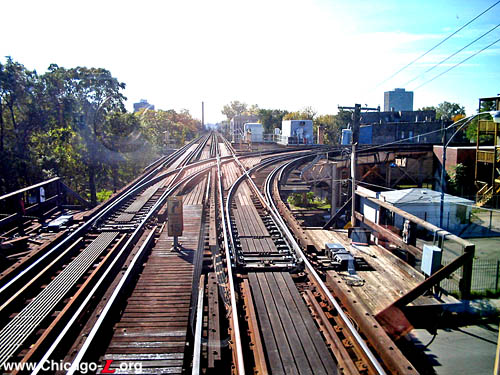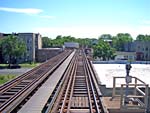|
|
|
|
 59th Junction, looking south on October 17, 2004 For a larger view, click here. (Photo by Tony Coppoletta) |
|
|
|
|
 59th Junction, looking south on October 17, 2004 For a larger view, click here. (Photo by Tony Coppoletta) |
59th
Junction
59th Street and Prairie
Avenue, Washington Park
Service Notes:
Services:
Green Line: Ashland-East 63rd
Quick Facts:
Established: November 3, 1905
Original Line: South Side Elevated
Rebuilt: 1965
Status: In Use
Profile:
59th Junction was created when the Englewood branch began operation to State Street on November 3, 1905, leaving the South Side Main Line just south of 59th Street.
The original interlocking at the junction consisted of a multi-story tower located between the Jackson Park and Englewood branches, on the south side of the junction, and a set of turnout switches protected by signals.
In the mid-1960s, a new automatic interlocking was put in service at 59th Junction. The contract for the new system was awarded to Moore Associates, of San Carlos, California, for $12,130 in early 1964. The installation was designed to be efficient and modern by providing for both automatic operation, and remote control from 61st Street Tower to reduce staffing needs.
Top: A local tower panel was provided at the junction in a cabinet on the side of the relay house for emergencies, see on August 18, 1965. It was not intended to be regularly staffed. For a larger view, click here. Above: A remote control panel was also provided in 61st Tower, two blocks away, seen on March 18, 1965. Although 59th was intended to normally operate automatically, if manual control was needed it was intended to typically occur from 61st Tower, which was always staffed. For a larger view, click here. (Both photos: George Krambles photo, courtesy of the Krambles-Peterson Archive) |
Described at the time as a centralized traffic control solid state coding system, the installation could control the signals and track switches in the approaches to the 59th Street junction. The new facility was housed in a sheet steel building erected adjacent to the old tower at 59th Junction. Design of interlocking circuitry and work of installing the equipment was done by the Signal Division of CTA's Electrical Department. In effect, the former installation became a modern, manual-automatic operation with remote supervisory control.
The new interlocking was designed to put in routes and clear signals automatically, sorting trains in an alternating A-B-A-B sequence, possible because southbound North-South Route trains simply alternated between the branches rather than being run as separately-scheduled services. This meant that unlike Paulina and Loomis junctions at the time, trains did not have carry indentra-coils, transponders, or other sorting devices that identified the trains' identity, simplifying the associated infrastructure and equipment. Northbound trains, which merged off the branches onto the main line, simply triggered the interlocking to put in the route on a first-come, first-served basis if no conflicting traffic was present. The intent was to operate the interlocking in this automatic mode most of the time.
A feature of the installation was a control panel suspended from the ceiling on the second floor of the 61st Street tower. The auxiliary control panel, approximately 12" x 18" in size, allowed the towerman to manually operate the interlocking from the tower two blocks south of the junction. Under manual control, train routing is made by pushing either the northbound or southbound "A" or "B" button to establish whatever route is desired. For switching or back-up moves at the junction (i.e. a train going from one branch to the other), line-ups are made by using auxiliary switch controls to establish the route and pushing a "C" button, used for a route other than an "A" or a "B" for whichever direction the move is to be made. The signals shown on the control panel are lights that flash on and off until the signals and trainstops are both cleared. It also had a switch which enabled the towerman to put the panel on automatic control. Lights on the panel indicated whether an "A" or "B" train was the last to go through the interlocking. Two-way transmission is provided by telephone cables connecting the 61st Tower and the interlocking equipment at 59th Street.
In addition to the panel in 61st Tower, there was a small tower panel on the side of the relay house at the junction. The local control panel was somewhat unusual in that while it had push-pull type buttons, it was not an "entrance-exit" panel, as most push-pull button panels were (and are), where the buttons are arranged on a track diagram on the panel to select the track circuits for the start (entrance) and end (exit) of the desired route through the interlocking. Rather, there were simply individual buttons for the "A" (Englewood) and "B" (Jackson Park) routings in each direction, along with a third "Other" button for each direction for branch-to-branch non-revenue moves -- when switched to local control, one simply pushed the routing button for the desired direction, and the signal system did the rest. The 1976 training materials for this tower panel also made clear that it was not intended to the staffed normally -- the junction was typically kept on automatic control, with the routes coming in automatically on an alternating A-B-A-B sequence. And even under unusual circumstances, such as a southbound work or non-revenue train or a train out of sequence interrupting the normal alternating sequence, the 61st towerman was intended to take control of 59th Interlocking by means of the remote panel in 61st Tower. Only if the 61st towerman could not control the interlocking for some reason was it intended for someone to control the junction interlocking from the 59th local panel.
In conjunction with the modernization of the block signal system, interlocking with speed control was installed between State Street on the Englewood branch, and Garfield Blvd. on the main line.
Installation of the equipment was completed around March 1965. On April 25, 1965, the new automatic interlocking was put in service at 59th Junction. On July 4, 1965, tower operation at 59th Junction was discontinued and the junction was converted to fully automatic operation. At the time, traffic at 59th Junction consisted of about 350 trains per day operating on a headway varying between 1-1/2 minutes during the rush hour to a maximum of 15 minutes during "non rush" periods.
A new relay house bungalow, signal equipment and local control panel were installed in the mid-1990s as part of the Green Line Renovation project, and entered service when the line reopened in May 1996. The tower was still typically unstaffed, and the new interlocking was regularly operated on automatic, with routes established on an alternating A-B-A-B sequence. The new interlocking could also still be remotely controlled from 61st Tower, as needed.
Effective at 12 noon, Monday, August 3, 2020, a new automatic routing system was implemented at 59th Junction. When 59th Junction is set to automatic operation, routes for southbound trains are established by a signal transmitted from the train, based on the terminal/destination entered by the operator on the car's Train Operator's Touch Screen (TOTS) interface in the motorcab (on a 5000-series car) at the beginning of the trip (the same input sets the train's destination signs, marker lights, and pre-recorded announcement sequence). A wayside receiver located approaching 59th Junction detects the signal from the passing train and sets the appropriate route at the junction. This method, based on the destination of the train actually set by the Operator rather than an alternating A-B-A-B sequence, helps prevent operators from getting the incorrect route at the junction when a train is missing from the schedule (due to an operator absence, service disruption, etc.) or other disruption to the alternating sequence (such as a nonrevenue train passing through) and two trains in a row are destined for the same branch. This system only works for 5000-series trains, however, as only the 5000s have the carborne equipment to transmit this information to the wayside receiver. If no destination has been entered on a 5000-series trains, or the train is made up of older equipment, the interlocking will not establish a route and the operator is required to use the wayside route selector to establish the desired route.
 |
59thJct02.jpg |
|
|